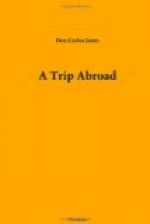Most of the streets in Smyrna are narrow and crooked, but there is one running along the water front that is rather attractive. On one side is the water, with the numerous vessels that are to be seen in this splendid harbor, and on the other side is a row of residences, hotels, and other buildings. The people turn out in great numbers at night and walk along this street, sometimes sitting down at the little tables that are set in the open air before places where different kinds of drinks are dispensed. Here they consume their drinks and watch the free performances that are given on an open stage adjoining the street and the grounds where they are seated. Perhaps the most peculiar thing about it all is the quiet and orderly behavior of this great crowd of people. While in this city I had occasion to go to the “Banque Imperiale Ottoman,” and learned that it was open in the forenoon and afternoon, but closed awhile in the middle of the day. I saw a street barber plying his trade here one day. A vessel of water was put up under the customer’s chin, and held there by keeping the chin down. The barber had his strop fastened to himself, and not to the chair or a wall, as we see it at home. Great quantities of oats were being brought down from the interior on camels. The sacks were let down on the pavement, and laborers were busy carrying them away. A poor carrier would walk up to a sack of grain and drop forward on his hands, with his head between them, and reaching down almost or altogether to the pavement. The sack of grain was then pulled over on his back, and he arose and carried it away. Some poor natives were busy sweeping the street and gathering up the grain that lost out of the sacks. There seems to be a large amount of trade carried on at this port. Several ships were in the harbor, and hundreds of camels were bringing in the grain. There are now many mosques and minarets in Smyrna, where there was once a church of God. (Revelation 2:8-11.)
On Wednesday, September twenty-first, I boarded a train on the Ottoman Railway for Ayassalouk, the nearest station to the ruins of Ephesus, a once magnificent city, “now an utter desolation, haunted by wild beasts.” We left Smyrna at seven o’clock, and reached Ayassalouk, fifty miles distant, at half-past nine. The cars on this railway were entered from to side, as on European railroads, but this time the doors were locked after the passengers were in their compartments. Ayassalouk is a poor little village, with only a few good houses and a small population. At the back of the station are some old stone piers, that seem to have supported arches at an earlier date. On the top of the hill, as on many hilltops in this country, are the remains of an old castle. Below the castle are the ruins of what I supposed to be St. John’s Church, built largely of marble, and once used as a mosque, but now inhabited by a large flock of martins.




